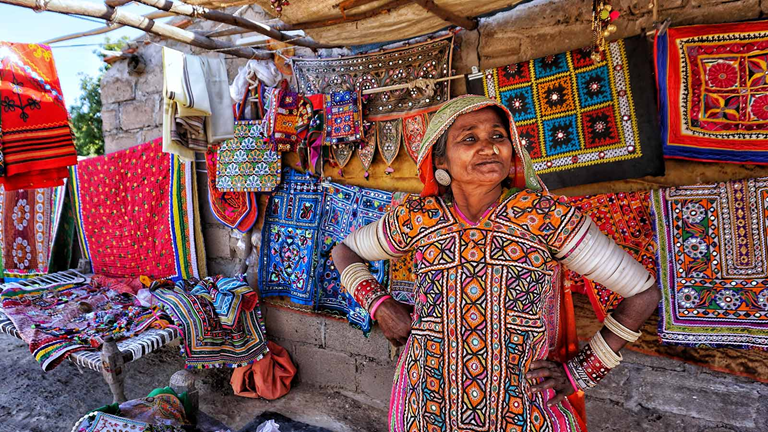- Courses
- GS Full Course 1 Year
- GS Full Course 2 Year
- GS Full Course 3 Year
- GS Full Course Till Selection
- Answer Alpha: Mains 2025 Mentorship
- MEP (Mains Enrichment Programme) Data, Facts
- Essay Target – 150+ Marks
- Online Program
- GS Recorded Course
- Polity
- Geography
- Economy
- Ancient, Medieval and Art & Culture AMAC
- Modern India, Post Independence & World History
- Environment
- Governance
- Science & Technology
- International Relations and Internal Security
- Disaster Management
- Ethics
- Current Affairs
- Indian Society and Social Issue
- NCERT- Science and Technology
- NCERT - Geography
- NCERT - Ancient History
- NCERT- World History
- CSAT
- 5 LAYERED ARJUNA Mentorship
- Public Administration Optional
- ABOUT US
- OUR TOPPERS
- TEST SERIES
- FREE STUDY MATERIAL
- VIDEOS
- CONTACT US
Kutch Ajrakh: A Cultural Textile Craft
Kutch Ajrakh: A Cultural Textile Craft
05-05-2024

Recently, the traditional artisans of the vibrant region of Kutch, Gujarat have been granted a Geographical Indication (GI) certificate for their famous textile craft, known as 'Kutch Ajrakh'.
About Kutch Ajrakh:
- Textile Craft:
- Ajrakh is a traditional textile craft deeply rooted in the cultural fabric of Gujarat, especially in the regions of Sindh, Barmer and Kutch.
- Its heritage shows the designs and rich symbolism achieved through hand-block printing on refined cotton fabric.
- Nomenclature:
- Ajrakh derives its name from 'Azrak,' which means indigo.
- Indigo is a well-known substance commonly used as a powerful dye to achieve the blue effect, which gives crafts their distinctive colour.
- Colors and Symbolism:
- Traditionally, Ajrakh prints have consisted of 3 colours:
- Blue, representing the sky
- Red, representing the land and fire
- White, representing the stars
- Traditionally, Ajrakh prints have consisted of 3 colours:
- Dyeing Process:
- The textiles are treated with vegetable and mineral dyes, and the fabric goes through about 8 wash cycles.
- Historical Origins:
- The craft of Ajrakh was introduced to the region over 400 years ago by the Sind Muslims.
- Cultural Significance:
- Nomadic pastoralists and agricultural communities like Rabari, Maldhari and Ahir wear Ajrakh printed cloth in the form of turban, lungi or stole.
Q. What is a Geographical Indication (GI) Tag?
- Sign of Origin: A GI tag is a sign or name used on products that have a specific geographical origin. This origin gives the product unique qualities, characteristics, or a reputation.
- Quality and Reputation: The GI tag acts as a guarantee that the product has certain qualities or enjoys a specific reputation due to its place of origin.
- Example: "Darjeeling tea" is a famous example. Only tea grown and processed in the Darjeeling region of India can be sold as "Darjeeling tea".
Why are GI tags important?
- Protection for Producers: GI tags protect the interests of traditional producers within a region. They prevent unauthorized use of a famous product name.
- Consumer Assurance: GI tag gives consumers confidence in the authenticity and quality of the product they are purchasing.
- Cultural Heritage: GI tags often recognize products with deep-rooted cultural or historical significance within a region. It promotes the preservation of traditional knowledge and practices.
- Economic Benefits: GI tags can enhance the prestige of a product and its region, leading to increased demand and potentially higher prices.
Who controls GI tags?
- In India: The Geographical Indications of Goods (Registration and Protection) Act, 1999 (GI Act) is administered by the Controller General of Patents, Designs and Trade Marks, who is also the Registrar of Geographical Indications. The Geographical Indications Registry, which is located in Chennai, handles applications and grants GI tags.
- Internationally: The World Trade Organization's (WTO) Agreement on Trade-Related Aspects of Intellectual Property Rights (TRIPS) provides a framework for countries to establish GI protection systems.
Examples of Products with GI Tags:
- India: Banarasi Sarees, Darjeeling Tea, Mysore Sandal Soap, Alphonso Mangoes
- Worldwide: Champagne (France), Scotch Whisky (Scotland), Roquefort Cheese (France), Tequila (Mexico)
Must Check: Best IAS Coaching In Delhi



